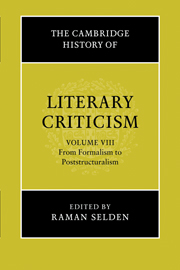Book contents
- Frontmatter
- Introduction
- 1 Russian Formalism
- STRUCTURALISM: ITS RISE, INFLUENCE AND AFTERMATH
- READER-ORIENTED THEORIES OF INTERPRETATION
- 9 Hermeneutics
- 10 Phenomenology
- 11 Reception theory: School of Constance
- 12 Speech act theory and literary studies
- 13 Other reader-oriented theories
- Bibliography
- Index
- References
11 - Reception theory: School of Constance
from READER-ORIENTED THEORIES OF INTERPRETATION
Published online by Cambridge University Press: 28 March 2008
- Frontmatter
- Introduction
- 1 Russian Formalism
- STRUCTURALISM: ITS RISE, INFLUENCE AND AFTERMATH
- READER-ORIENTED THEORIES OF INTERPRETATION
- 9 Hermeneutics
- 10 Phenomenology
- 11 Reception theory: School of Constance
- 12 Speech act theory and literary studies
- 13 Other reader-oriented theories
- Bibliography
- Index
- References
Summary
Introduction
Reception theory is commonly used to designate a direction in literary criticism developed by professors and students at the University of Constance in West Germany during the late 1960s and early 1970s. The School of Constance advocated turning to the reading and reception of literary texts instead of to traditional methods that emphasize the production of texts or a close examination of texts themselves. To this extent its approach is related to reader-response criticism as it appeared in the United States during these same years, although the School of Constance for a time was much more homogeneous in its theoretical presuppositions and general outlook than its American counterpart. Also known as ‘The Aesthetics of Reception’ (Rezeptionsästhetik), the approach developed by the School dominated literary theory in Germany for about a decade. It was virtually unknown in the English-speaking world until around 1980 when it was made more readily accessible by a number of translations of the most seminal works. Hans Robert Jauss (1921– ) and Wolfgang Iser (1926– ) are the two most original theorists of the Constance School, although several of Jauss’ students, among them Rainer Warning, Hans Ulrich Gumbrecht, Wolf-Dieter Stempel and Karlheinz Stierle, also made important contributions to this branch of theory. In response to the writings of Jauss and Iser, scholars from the German Democratic Republic such as Robert Weimann, Claus Träger, Manfred Naumann, and Rita Schober raised objections to some propositions and suggested Marxist alternatives, and the most productive East–West postwar dialogue in literary theory involved issues of reception and response.
- Type
- Chapter
- Information
- The Cambridge History of Literary Criticism , pp. 319 - 346Publisher: Cambridge University PressPrint publication year: 1995
References
- 11
- Cited by

